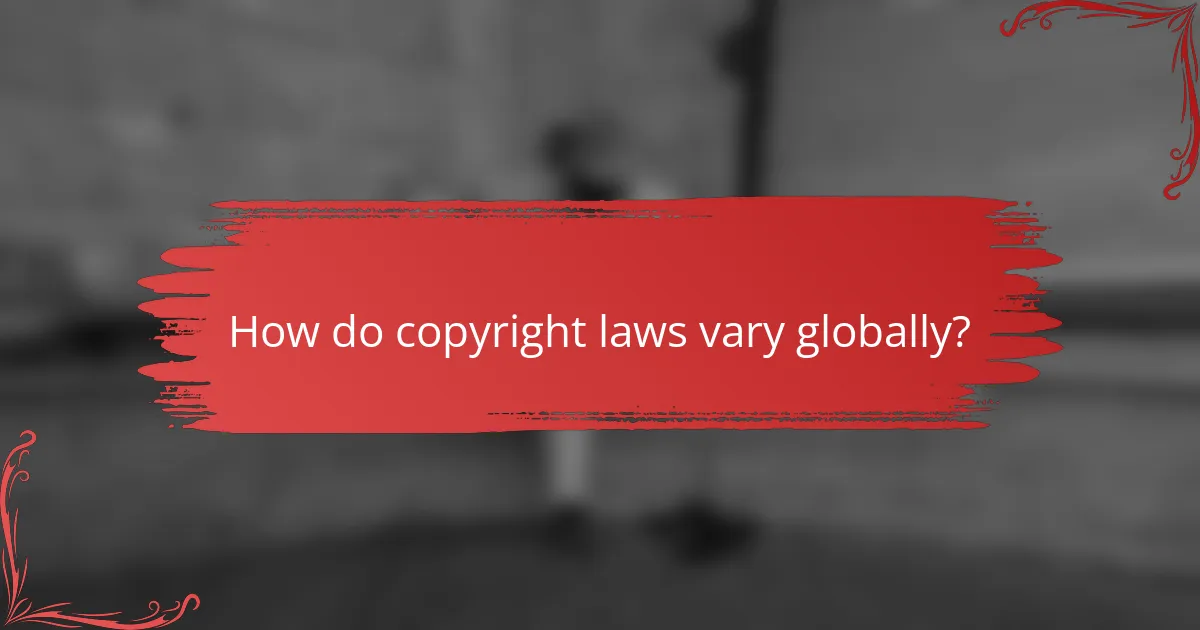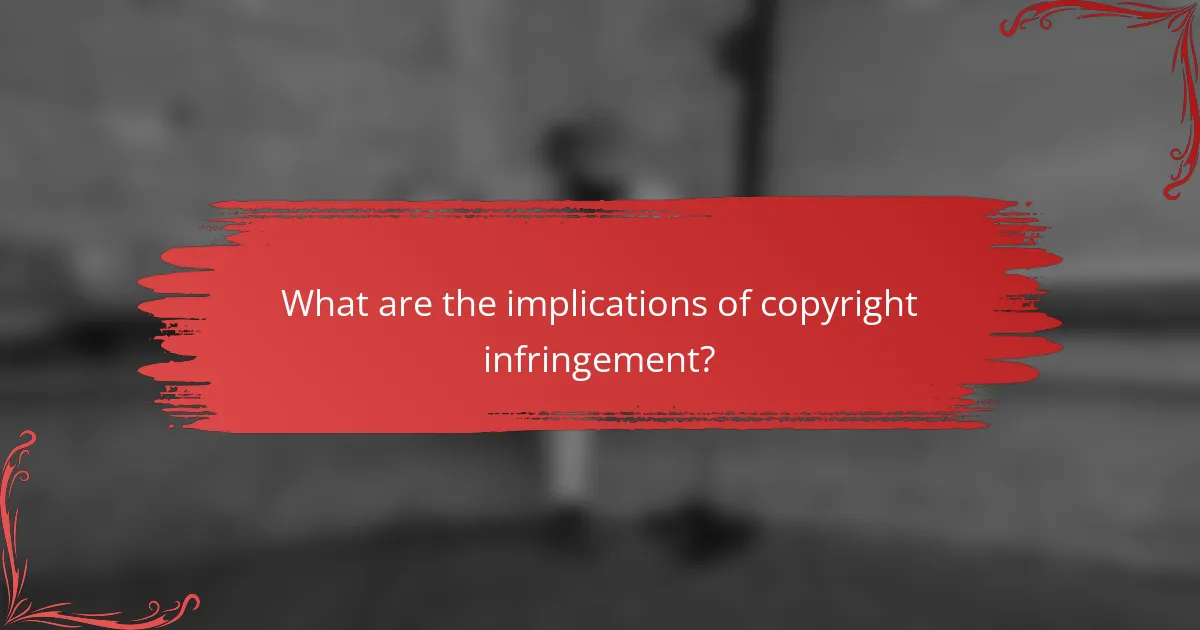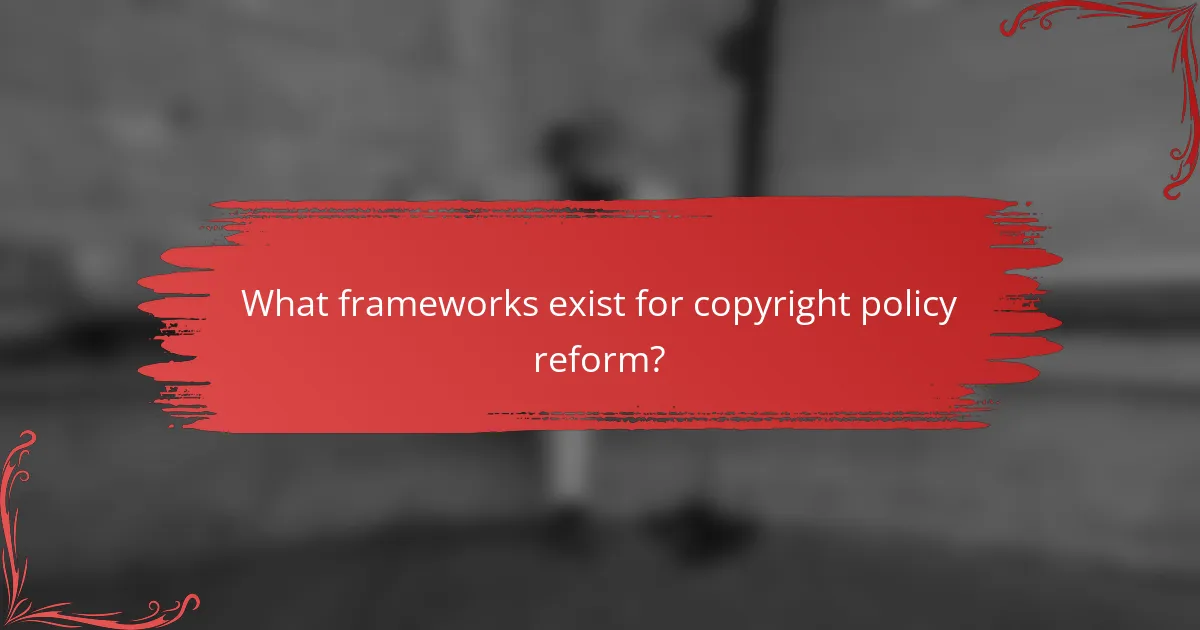Copyright laws play a crucial role in protecting the rights of creators and regulating the use of their works. Compliance with these laws is essential for businesses to avoid infringement and legal disputes, particularly in an increasingly digital landscape. However, navigating the complexities of copyright can present significant challenges, including claims of infringement and content ownership issues, which require proactive management and education to mitigate risks.

What are the key copyright laws in the United States?
The key copyright laws in the United States are designed to protect the rights of creators and ensure that their works are not used without permission. These laws establish the framework for copyright protection, including the duration of rights, the scope of protection, and exceptions such as fair use.
Copyright Act of 1976
The Copyright Act of 1976 is the foundational law governing copyright in the U.S. It grants authors exclusive rights to reproduce, distribute, and display their original works. This law also established the duration of copyright protection, which generally lasts for the life of the author plus 70 years.
Under this act, works are automatically protected upon creation, meaning registration is not required for copyright protection, although it provides legal advantages. It covers a wide range of works, including literary, musical, and artistic creations.
Digital Millennium Copyright Act
The Digital Millennium Copyright Act (DMCA), enacted in 1998, addresses copyright issues in the digital age. It criminalizes the circumvention of digital rights management (DRM) technologies and provides a safe harbor for online service providers, protecting them from liability for user-generated content as long as they comply with takedown requests.
The DMCA also includes provisions for the protection of copyrighted works on the internet, making it crucial for content creators and distributors to understand their rights and responsibilities in the digital landscape.
Fair Use Doctrine
The Fair Use Doctrine allows limited use of copyrighted material without permission from the rights holder, primarily for purposes such as criticism, comment, news reporting, teaching, scholarship, or research. This doctrine is essential for balancing the interests of copyright owners with the public’s right to access information.
Determining fair use involves a case-by-case analysis based on four factors: the purpose and character of the use, the nature of the copyrighted work, the amount used, and the effect on the market for the original work. Understanding these factors can help individuals navigate potential copyright issues effectively.

How to ensure compliance with copyright laws?
Ensuring compliance with copyright laws involves understanding the legal requirements and taking proactive steps to avoid infringement. This includes obtaining necessary licenses, educating staff, and utilizing management tools to track usage of copyrighted materials.
Obtain licenses for copyrighted materials
To comply with copyright laws, it is essential to obtain licenses for any copyrighted materials you plan to use. This can include music, images, videos, and written content. Licensing agreements can vary in cost, often ranging from a few dollars to thousands, depending on the material and usage rights.
Consider using platforms that offer royalty-free or Creative Commons licensed content, which can simplify the licensing process. Always read the terms of the license to ensure your intended use is covered.
Implement copyright training programs
Training programs on copyright laws are crucial for employees who handle content creation or distribution. These programs should cover the basics of copyright, the importance of compliance, and the consequences of infringement. Regular training sessions can help reinforce knowledge and keep staff updated on any changes in copyright regulations.
Consider providing resources such as handbooks or online courses to make the training accessible. Engaging employees with real-world examples of copyright issues can enhance understanding and retention.
Use copyright management tools
Copyright management tools can help organizations track and manage their use of copyrighted materials effectively. These tools often include features for monitoring usage, managing licenses, and ensuring compliance with legal requirements. Popular options include digital asset management systems and copyright compliance software.
When selecting a tool, look for features that align with your organization’s size and needs. Many tools offer free trials, allowing you to evaluate their effectiveness before committing to a subscription.

What challenges do businesses face regarding copyright?
Businesses encounter several challenges related to copyright, including infringement claims, content ownership disputes, and the need to adapt to digital content. These issues can lead to legal complications, financial losses, and operational hurdles if not managed effectively.
Infringement claims
Infringement claims arise when a business uses copyrighted material without permission, leading to potential lawsuits. Companies must be vigilant in ensuring that their use of content, such as images, music, or text, complies with copyright laws to avoid costly legal battles.
To mitigate risks, businesses should conduct thorough copyright audits and maintain clear documentation of licenses and permissions. Engaging legal counsel for guidance on copyright compliance can also be beneficial.
Content ownership disputes
Content ownership disputes often occur when multiple parties claim rights to the same material, leading to conflicts over who can use or profit from it. This is particularly common in collaborative projects where contributions from various creators may not be clearly defined.
To prevent ownership disputes, businesses should establish clear contracts outlining the rights of all contributors before starting a project. Regular communication and documentation of contributions can help clarify ownership and reduce misunderstandings.
Adapting to digital content
Adapting to digital content presents unique challenges, as the ease of sharing and reproducing material online can lead to unintentional copyright violations. Businesses must navigate the complexities of digital rights management and licensing agreements to protect their intellectual property.
Implementing robust digital rights management tools and educating employees about copyright laws can help businesses safeguard their content. Additionally, staying updated on evolving regulations regarding digital content is crucial for compliance and risk management.

How do copyright laws vary globally?
Copyright laws differ significantly across countries, influenced by local regulations, cultural norms, and international treaties. Understanding these variations is crucial for creators and businesses operating in multiple jurisdictions.
Berne Convention signatory countries
The Berne Convention for the Protection of Literary and Artistic Works establishes a framework for copyright protection among its signatory countries. Currently, over 170 countries are members, ensuring that works created in one member state are recognized and protected in others without the need for formal registration.
For example, a book published in France is automatically protected in Germany, allowing authors to benefit from their rights internationally. However, the duration of protection and specific rights may still vary by country.
EU Copyright Directive
The EU Copyright Directive aims to harmonize copyright laws across European Union member states, addressing challenges posed by digital content. This directive includes provisions for fair use, exceptions for education, and measures to enhance the protection of authors and creators.
For instance, the directive mandates that platforms hosting user-uploaded content must take steps to ensure copyright compliance, impacting how companies operate within the EU. Businesses must stay informed about these regulations to avoid penalties.
Regional differences in enforcement
Enforcement of copyright laws can vary widely between regions, affecting how effectively rights are upheld. In some countries, enforcement mechanisms are robust, with strong penalties for infringement, while others may lack the resources or political will to enforce laws effectively.
For example, in the United States, copyright infringement can lead to significant financial penalties and legal action, whereas in certain developing countries, enforcement may be less stringent, leading to higher rates of piracy. Understanding these regional differences is essential for creators looking to protect their work globally.

What are the implications of copyright infringement?
Copyright infringement can lead to significant legal, financial, and reputational consequences for individuals and businesses. Understanding these implications is crucial for compliance and risk management.
Legal penalties
Legal penalties for copyright infringement can range from monetary fines to imprisonment, depending on the severity of the violation. In many jurisdictions, penalties can include statutory damages, which may amount to thousands of dollars per infringement, and in some cases, even higher amounts for willful violations.
Additionally, copyright holders may pursue injunctions to prevent further infringement, which can disrupt business operations. It is essential to consult legal professionals to navigate these potential risks effectively.
Financial losses for creators
Creators often face substantial financial losses due to copyright infringement, as unauthorized use of their work can lead to decreased sales and revenue. For instance, a musician whose songs are illegally downloaded may see a significant drop in album sales, impacting their overall income.
Moreover, the financial impact extends beyond immediate losses; it can also affect future earnings and opportunities. Creators should consider proactive measures, such as registering their works and monitoring usage, to mitigate these risks.
Impact on brand reputation
Copyright infringement can severely damage a brand’s reputation, leading to a loss of trust among consumers and partners. Companies found guilty of infringing on copyrights may be viewed as unethical, which can deter potential customers and collaborators.
Maintaining a strong commitment to copyright compliance not only protects a brand’s image but also fosters goodwill within the industry. Brands should implement clear policies and training for employees to ensure adherence to copyright laws and promote a culture of respect for intellectual property.

What frameworks exist for copyright policy reform?
Various frameworks for copyright policy reform aim to balance the rights of creators with public access to information. These frameworks often involve international treaties, national legislation, and collaborative initiatives among stakeholders.
International Treaties
International treaties like the Berne Convention and the Agreement on Trade-Related Aspects of Intellectual Property Rights (TRIPS) set foundational standards for copyright protection across member countries. These agreements establish minimum protection levels and facilitate cooperation among nations in enforcing copyright laws.
Countries may adapt their national laws to comply with these treaties, which can lead to significant changes in local copyright policies. For instance, adherence to TRIPS requires nations to provide certain rights to creators, impacting how copyright is enforced and upheld globally.
National Legislation
National legislation is crucial for implementing international treaties and addressing local copyright issues. Each country has its own copyright laws that reflect cultural values, economic needs, and technological advancements. For example, the Digital Millennium Copyright Act (DMCA) in the United States addresses online copyright infringement and the responsibilities of internet service providers.
Reform efforts often focus on updating these laws to tackle challenges posed by digital content sharing and emerging technologies. Policymakers must consider the interests of creators, consumers, and technology companies when drafting or amending copyright laws.
Collaborative Initiatives
Collaborative initiatives among governments, industry stakeholders, and civil society organizations play a vital role in shaping copyright policy reform. These initiatives often seek to address the complexities of digital copyright issues through dialogue and consensus-building.
Examples include public consultations and stakeholder forums that gather input from various parties affected by copyright laws. Such collaborations can lead to more balanced policies that consider the needs of both creators and the public, fostering a more equitable copyright environment.
